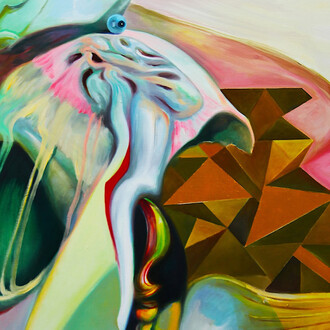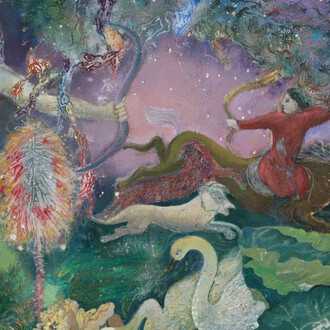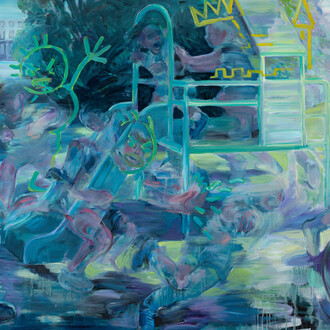Kiang Malingue is pleased to present at its New York space After h(ours), an exhibition by the 2025 graduates of the Yale School of Art MFA Sculpture Department. The exhibition title draws from H(ours), a thesis exhibition title by the cohort that was organized by Kameelah Janan Rasheed and Aki Sasamoto. Artists include: Nic[o] Brierre Aziz, Brenda Barrios, Helen Liene Dreifelds, Sam Frésquez, Alice Gōng Xiaowén, Jesús Hilario-Reyes, Andrew Luk, Gozié Ojini, Alix Vernet, and Omer Wasim.
After h(ours) considers sculpture as a time-based medium that recasts the afterlife of objects and materials, constellating multivalent space-time nodes: to map forgotten histories, to reroute perceptual systems, and to conceive new consciousness. Through a mutability that brings into fluid relation myriad mediums, such as drawing, sound, and performance, sculptures flit between evidence, index, record, and proof, or altogether at once. Nested with possibilities, sculptures act as an echolocation in search for “what comes after,” such as ensconced in the time of day that operates under the radar, cloistered in the furtive and rapturous space of communal invisibility, through transactions beyond legal boundaries and conventional protocols, and protected in the safe spaces shielded from surveillance. These are volatile spaces of amplitude, where crystallization of seismic shifts can be detected on an intimate scale, where a new star map of collectivity and temporality can be braided. In upending chronologies and knowledge systems towards futurity, After h(ours) proposes a new ground and an excavation, of what sociologist Paul Gilroy speaks of as the “collective work of salvage,” towards an ecology of what poet Fahima Ife calls the “porous aftermath.”
Nic[o] Brierre Aziz employs strategies of satire, absurdity, and word play, to unravel personal and collective narratives, drawing from contemporary pop culture while establishing extraction as a conceptual base to illuminate histories related to land, lineage, and ritual. Objects for performances or laden with potential, such as those holding the coexistence of mourning and celebration in jazz funeral practice, map a visual cosmology and a cartography of identity to imagine reverberant futures.
Brenda Barrios weaves the tropes of autobiography, in particular the artist’s Mexican-American identity and autoimmune condition, towards a celebratory pathway of healing and agency. The devotional form of milagros charms, traditionally carried for healing purposes and as votive offerings, are rendered in enlarged forms holding imprints and symbols of distressed body parts of stomach, heart, and feet. Further rousing mobility is a lifelike doll of the artist with interchangeable attire, such as a Mexican soccer jersey with customized sleeves, animated for each occasion.
Helen Liene Dreifelds’ work encompasses metal fabrication, handweaving, assemblage, lens-based media, and is concerned with relationality and the histories of transculturation and (mis)translations of material systems. Exploring the perception of touch in natural sciences, phenomenology, and mechanical systems such as the Jacquard loom, and investigating how pressure, contact, and energy transfers can uncover latent emotional state and perceptual slippages, her work fosters a heightened awareness of the individual in relation to the collective, as a poetics of what remains just out of reach.
Alice Gōng Xiaowén transmits the generative tension in sensory perception through the reconfiguration and unmooring of objects from their linear histories, processed through the translation of casting and image making. She re-routes material histories and tracks their ideological shifts, such as the silk strings of guzheng and guqin, and language and writing inscribed on wooden foundry patterns for varying scales of U.S. infrastructure, into works that articulate and narrate their materiality.
Jesús Hilario-Reyes’s sculptural and performative practice traces the fugitivity of Black subjecthood and the transformative space of queer collectivity and nightlife, rooted in the traditions of Caribbean carnival and rave culture. The dance floor is a fulcrum, evidence of communal embodiment where devotional and bodily markmaking of blurring, smudging, and edging can transport and recenter the margins. Through tactics of abstraction and overlay, Hilario-Reyes transforms quotidian architecture and spaces into ecstatic zones of transcendence.
Andrew Luk’s work entangles historical and speculative events through a refracted lens that blurs science fiction and space exploration, such as the Apollo-Soyuz Test Project in 1975 that sensationalized the handshake in space by American astronaut Thomas P. Stafford and Soviet cosmonaut Aleksei A. Leonov. By coalescing fragments of artifacts and objects instrumentalized by corporatized imperialist bureaucracy, Luk implores viewers to take note of their implication in perceptual calibration ascribed to evolving value systems, and social and political consciousness.
Gozié Ojini suspends the life cycle of objects to redistribute their material, social, and historical weight, intertwining the polysemic concept of burden, often titling his works after their physical weight. Tending to the intellectual and emotional resonances in Black music, the generative potential of breakdown–referring to the shift in rhythm and melody and stripped down sonic structure, as well as the disassembly of found objects–he transforms objects into instruments, and instruments into objects, such as the arrangement of piano keys into a cipher of a bloom or an explosion, and a back leather couch emitting a haptic frequency.
Alix Vernet explores the layered rituals, histories, and life cycles of public space and the built environment. Hybridizing practices that emerge from conservation, street art, and sculpture, her projects frequently involve unlikely collaborators, from monument technicians, to priests and passersby. In a body of work rooted in the life of an early 20th century building—once an erotic emporium owned by a Times Square impresario, and demolished by an architectural salvage dealer who also runs an escape room, Vernet collides overlapping narratives to examine how desire, value, gender, and performance are embedded in architectural spaces.
Through architectural thresholds in constellation with drawings and objects, Omer Wasim entangles botanical, geological, and quotidian histories, to activate a sensorial agency that subverts extraction, authority, and the nation state. By making visible the ruins, ruinations, and traces of imperial toxicity and militarized states in South Asia, and their sediments into material, social, and environmental ecologies, Wasim’s porous portals enable practices of belonging, survival, generational knowledge, and new discourses.
(Text by Jo-ey Tang)












